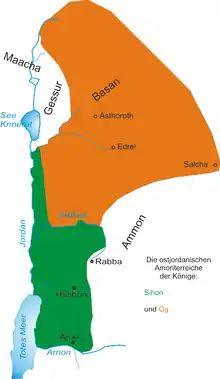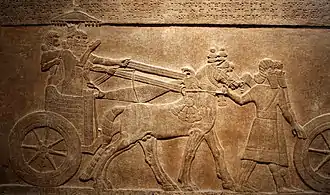Bashan
Bashan (/ˈbeɪʃən/; Hebrew: הַבָּשָׁן, ha-Bashan; Latin: Basan or Basanitis[2]) is a term for the northernmost region of the Transjordan,[3] which is located in what is today known as Syria. The Hebrew Bible first mentions it in Numbers 21:33, where Og the king of Bashan came out against the Israelites at the time of their entrance into the Promised Land, but was vanquished in battle (Numbers 21:33–35; Deuteronomy 3:1–7).[4] Along with the half of Gilead it was given to the half-tribe of Manasseh (Joshua 13:29–31). According to the book of Joshua, Golan, one of its cities, became a Levitical city and a city of refuge (Joshua 21:27).


According to the Torah, the Israelites invaded Bashan and conquered it from the Amorites. Deuteronomy 3:1–7 states:
Then we turned, and went up the way to Bashan: and Og the king of Bashan came out against us, he and all his people, to battle at Edrei. And the LORD said unto me, Fear him not: for I will deliver him, and all his people, and his land, into thy hand; and thou shalt do unto him as thou didst unto Sihon king of the Amorites, which dwelt at Heshbon. So the LORD our God delivered into our hands Og also, the king of Bashan, and all his people: and we smote him until none was left to him remaining. And we took all his cities at that time, there was not a city which we took not from them, threescore cities, all the region of Argob, the kingdom of Og in Bashan. All these cities were fenced with high walls, gates, and bars; beside unwalled towns a great many. And we utterly destroyed them, as we did unto Sihon king of Heshbon, utterly destroying the men, women, and children, of every city. But all the cattle, and the spoil of the cities, we took for a prey to ourselves.
Argob, in Bashan, was one of Solomon's commissariat districts (1 Kings 4:13). The cities of Bashan were taken by Hazael (2 Kings 10:33), but were soon after reconquered by Jehoash (2 Kings 13:25), who overcame the Syrians in three battles, according to the prophecy of Elisha (2 Kings 13:19). From this time, Bashan almost disappears from history, although we read about the wild cattle of its rich pastures (Ezekiel 39:18; Psalm 22:12), the oaks of its forests (Isaiah 2:13; Ezekiel 27:6; Zechariah 11:2), the beauty of its extensive plains (Amos 4:1;[5] Jeremiah 50:19), and the rugged majesty of its mountains (Psalm 68:15). Soon after the conquest, the name "Gilead" was given to the whole country beyond Jordan.
References
- Jones, Clifford M. (1971). Old Testament Illustrations. CUP Archive. p. 77.
- Barrington Atlas of the Greek and Roman World. See .
- Edward Lipiński (2006). On the Skirts of Canaan in the Iron Age: Historical and Topographical Researches. Peeters Publishers. p. 225. ISBN 978-90-429-1798-9.
- "Bashan". Encyclopædia Britannica. Retrieved 7 February 2014.
- "BibleHub - Amos 4:1". Retrieved 7 February 2014.
Further reading
- Aharoni, Yohanan (1 January 1979). "The Transjordanian Highlands". The Land of the Bible: A Historical Geography. Westminster John Knox Press. pp. 36–42. ISBN 978-0-664-24266-4.
- MacDonald, Burton (2000). "Settlement of the Israelite Tribes East of the Jordan". In Matthews, Victor (ed.). East of the Jordan: Territories and Sites of the Hebrew Scriptures. American Schools of Oriental Research.
- Porter, Rev. J. L. (1867). The Giant Cities of Bashan; and Syria's Holy Places.
External links
- Golan Heights (Biblical Bashan) on Bibleplaces
